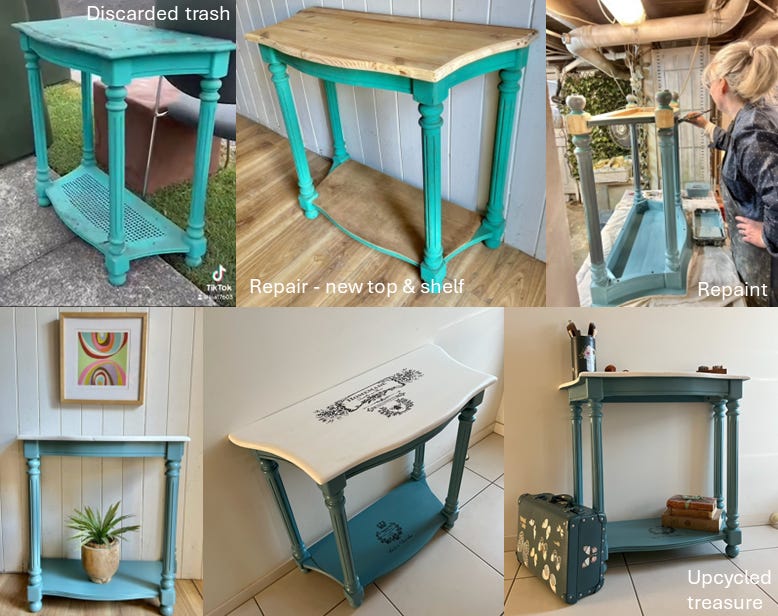Turning Trash into Treasure
Discovering the Art of Upcycling with LoveLea Designs: Sustainability Meets Style
When we talk about creating a regenerative city, one of the key ideas is the concept of a circular economy. This means rethinking how we use resources and managing waste more effectively. You might be familiar with the 3 Rs: reduce, reuse, recycle. Did you know, though, that they are part of a hierarchy and recycling is actually the last resort of these three? The best thing we can do is to reduce what we buy, but reuse is a close second, often overlooked yet incredibly impactful.
Ever heard the saying, "one person’s trash is another person’s treasure"? This is the driving force behind a furniture upcycling enterprise in Wavell Heights. A couple of weeks ago, I attended a workshop hosted by LoveLea Designs, where I got to breathe new life into a hall table that was on its way to the landfill. Lea and her husband, James, who run the workshop, had rescued the table from the kerbside collection. With their guidance, I transformed it into something beautiful and functional.
Lea and James are passionate about rescuing discarded furniture from the kerbside and turning it into stylish, eco-friendly pieces. They show how second-hand items can be chic and sustainable, teaching valuable upcycling techniques in their workshops. Lea has been upcycling furniture for decades and willingly shares her advice and experience. Almost everything they use is saved from the landfill, sourced from kerbside collections, council tip shops, trash treasure markets, garage sales, and even donations from customers.
Their commitment to waste reduction is at the heart of LoveLea Designs. They prove that you can create beautiful, unique furniture while also making a significant environmental impact. Each rescued item is carefully repaired, and sanded, then transformed at the workshop, adding character and history to each piece. No two pieces are the same, offering workshop attendees one-of-a-kind items that tell a story.
During the workshop, I heard firsthand how Lea and James, scour Brisbane’s kerbside cleanups for hidden gems. They find everything from old chairs and tables to vintage dressers, which they then prepare ready for someone to transform into stylish new creations at their workshops. This process not only reduces waste but also promotes a culture of conscious consumption.
LoveLea Designs' work aligns perfectly with Sustainable Development Goals (SDGs) 11 and 12, which focus on sustainable cities and communities, and responsible consumption and production. Through upcycling, we can significantly cut down on the amount of waste heading to landfills, demonstrating how creative solutions can address waste management challenges.
The impact of LoveLea Designs goes far beyond just furniture. Their workshops educate the community about upcycling and demonstrate that reusing items is not a compromise—in fact, it's a superior choice resulting in beautiful and unique conversation pieces. They show that it’s easy to create beautiful, stylish pieces from salvaged items, encouraging more people to embrace upcycling as a viable and desirable option.
In a world facing the consequences of overconsumption and waste, LoveLea Designs proves that sustainability and style can coexist. Their initiative not only produces unique, functional items but also makes a significant contribution to waste reduction, inspiring others to rethink their consumption habits and embrace the potential of upcycling.
Upcycling vs. Recycling: What's the Difference?
While upcycling might sound like a trendy buzzword, the distinction between them is significant, especially when it comes to sustainability.
Here's a quick breakdown: Recycling involves breaking down an item into raw materials to create something new. For example, melting down used glass bottles to make a lamp base. Upcycling, on the other hand, transforms the item (all or in part) directly without breaking it down. That same glass bottle could be cleaned and used as a lamp base as it is. The resulting product can be either functionally similar to or very different from the old one.
Upcycling is not just about reusing—it's about creatively repurposing items, often resulting in unique, functional pieces. This method reduces environmental impact since it skips the energy-intensive process of breaking items down into raw materials (which is a fundamental part of recycling). LoveLea Designs demonstrates this by transforming discarded items into stylish, functional furniture without the need for energy-intensive processes proving that sustainability can be both practical and stylish.




